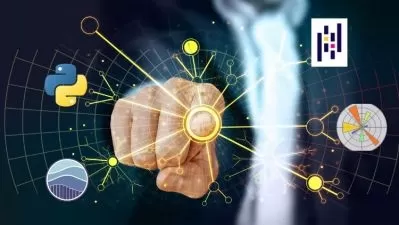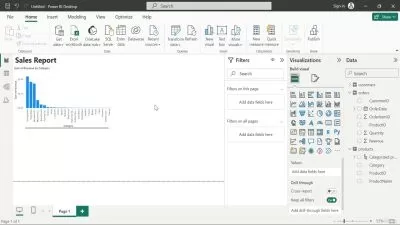Big Data: How Data Analytics Is Transforming the World
Tim Chartier
12:38:11
Description
Data is everywhere, shedding light on all aspects of life. Retailers know what’s selling and who’s buying. Pollsters test opinions on everything from candidates to consumer goods. Doctors follow their patients’ vital signs. Social networks register the interactions of millions. Sensors measure the changing weather. And as athletes play, fans collect exhaustive statistics on their performance.
If something can be measured, then in all likelihood a vast archive of data is already being compiled—and it is growing daily. Often, the data is unprocessed, waiting for someone to analyze it and discover new, valuable knowledge about the world.
This is the role of data analytics, a powerful set of tools for making sense of datasets of all sizes—from a personal exercise log to the massive collections of “big data” that define our information age. From science to sales, from sociology to sports, data analytics is unraveling the fascinating secrets hidden in numbers, patterns, relationships, and information of every kind.
Consider these examples:
- Cell phone science: If you are an avid user of your cell phone, try downloading several months of your calling data. You may see daily and long-term patterns in your usage that surprise you. Plus, any changes in your routine, such as a vacation, will show up prominently.
- Hardball analytics: The book and film Moneyball tell how the Oakland A’s overcame one of the smallest budgets in major league baseball to assemble a division-winning team. The secret? Managers used overlooked data analytics to hire undervalued, high-performing players.
- Presidential prediction: In the 2012 presidential election, statistician Nate Silver and a few others correctly predicted the winner of all 50 states and the District of Columbia. Here, weighting criteria make it possible to analyze data collected by hundreds of pollsters from thousands of distinct polls.
In our age of accelerating progress in so many fields, it’s easy to lose sight of the underlying innovation that makes this revolution possible. In case after case, the big breakthrough comes from data analytics, the mathematical magic that turns undigested information into life-transforming insights and advances.
Big Data: How Data Analytics Is Transforming the World introduces you to the key concepts, methods, and accomplishments of this versatile approach to problem solving. Taught by Professor Tim Chartier, an award-winning Associate Professor of Mathematics and Computer Science at Davidson College, these 24 half-hour lectures give you the big picture on big data, highlighting the crucial role of data analytics in today’s world and the even greater impact it will have in the future.
A Course for Data Users at All Levels
You need no expertise in mathematics to follow this exciting story. Professor Chartier explains the basic computational techniques used in data analytics, but his focus is on how these ideas are applied and the amazing results they achieve. His wealth of case histories and his many helpful graphics make Big Data both accessible and entertaining. Those who will benefit from his presentation include
- those in business, government, science, and other endeavors, who want a view into what data analytics can do for them;
- the intellectually curious, eager to investigate the role of computing and “data scraping” in the modern-day miracles of the information age;
- math enthusiasts who relish seeing a wide range of mathematical techniques address practical challenges;
- those considering, or already pursuing, work with data and aspiring to explore the full scope of their remarkable field; and
- anyone who relies on the Internet, smart phones, social media, or other tools that make them a participant in the data analytics revolution.
Big Data at Work
The volume, velocity, and variety of available data have increased at an astonishing rate during the last twenty years. That is to say, there are vast amounts of stockpiled data, and more is being generated constantly; the speed at which data is used, updated, and overturned in favor of newer data continues to accelerate; and data comes from many different sources and can be put to diverse uses. The miracle of data analytics is that ingenious algorithms are able to process this data deluge, which has been compared to trying to drink from a fire hose of information.
For instance, in just fifteen minutes the number of photos uploaded to Facebook exceeds the total number of photographs stored in the New York Public Library’s photo archives. Yet you can see a picture on your Facebook news feed within seconds after it’s posted. A high-speed computer algorithm allows the flood of imagery to be managed in a way that’s both timely and orderly. Professor Chartier explains how programmers achieve such feats by focusing only on the data that’s crucial to a specific task, while ignoring everything that’s irrelevant.
Big Data takes you behind the scenes to witness many examples of data analysis in action, including the following:
- Google Flu Trends: Google search queries on flu symptoms have sometimes proved more accurate and up-to-date at plotting the spread of flu than reports issued by doctors and hospitals. Explore the pitfalls and enormous potential of Internet traffic for charting many different trends.
- Online recommendations: Predictive analytics deals with forecasting the future, a task taken very seriously by companies like Netflix and Amazon that aim to predict what customers want. Learn how Netflix came up with an impressively accurate movie recommendation algorithm.
- March Madness: A classic exercise in data analytics is predicting the playoff winners of the NCAA basketball tournament, held every March. Follow the system for filling the game brackets, designed by Professor Chartier, and see how it applies to many other problems.
But big data and data analytics can also be a mixed blessing. While the field has revolutionized fraud detection, making many kinds of transactions much more secure, it has the potential to threaten personal privacy in ways that can be hard to spot. In this course, you learn that one of the best defenses for privacy is to know how data is compiled and processed, and which activities are the most compromising.
A Tool for Everyone
Honored as the Mathematical Association of America’s first ever Math Ambassador, Professor Chartier is a champion of the fun, challenge, and breathtaking power of mathematics—qualities that are beautifully illustrated in data analytics.
He especially relishes the links between sports and math. Not only does data analytics give you deep insight into the relative qualities of players, but it can establish a theoretical limit on performance—as when you learn how to estimate the fastest possible time for the 100-meter dash.
Professor Chartier also describes how simple analysis improved his own performance as a swimmer—which illustrates a key point: data analytics can be put to use by anybody for any problem that involves a dataset, no matter what size.
With Big Data, you discover tools that are transforming the world and that you can use to transform your own life. It’s like watching a thrilling spectator sport that invites you to suit up and join the action!
More details
User Reviews
Rating
Tim Chartier
Instructor's CoursesDr. Tim Chartier is an Associate Professor of Mathematics and Computer Science at Davidson College. He holds a B.S. in Applied Mathematics and an M.S. in Computational Mathematics, both from Western Michigan University. He received his Ph.D. in Applied Mathematics from the University of Colorado Boulder.
Professor Chartier is a recipient of a national teaching award from the Mathematical Association of America (MAA). He is the author of Math Bytes: Google Bombs, Chocolate-Covered Pi, and Other Cool Bits in Computing and coauthor (with Anne Greenbaum) of Numerical Methods: Design, Analysis, and Computer Implementation of Algorithms. As a researcher, he has worked with both Lawrence Livermore National Laboratory and Los Alamos National Laboratory, and his research was recognized with an Alfred P. Sloan Research Fellowship.
Dr. Chartier is a member and past chairperson of the Advisory Council for the National Museum of Mathematics, and was named the first Math Ambassador of the Mathematical Association of America. He fields mathematical questions for ESPN’s Sport Science program and has served as a resource for the CBS Evening News, National Public Radio, The New York Times, and other major news outlets.

The Great Courses
View courses The Great Courses- language english
- Training sessions 25
- duration 12:38:11
- Release Date 2024/12/02










